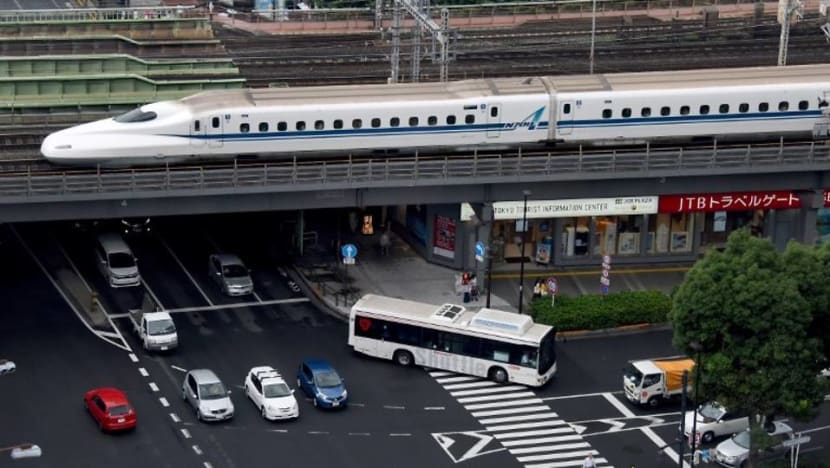Japan’s Shinkansen turns 60: The bullet train that transformed travel
Dubbed the “bullet train” for its sleek design and blistering speed, the Shinkansen was the world’s first high-speed rail service.

File photo of a Shinkansen bullet train 500-type speeding in front of Mt Fuji in Shizuoka.
Sixty years ago, a sleek white bullet train sliced through the Japanese countryside, marking a new era in travel.
It wasn’t just speed that set the Shinkansen apart – it was a symbol of Japan’s post-war transformation, a technological marvel that reshaped cities and inspired the world.
Here's a look back at the history of the Shinkansen and how it set the path for the future of transportation.
BEGINNING OF SHINKANSEN
On Oct 1, 1964, just days before Japan hosted its very first Olympic Games, the country unveiled one of its most ambitious projects.
Dubbed the “bullet train” for its sleek design and blistering speed, the Shinkansen, which means new trunk line, was the world’s first high-speed rail service.
The inaugural route - the Tokaido Shinkansen - linked Japan’s two largest cities, Tokyo and Osaka. It covered 515km in just four hours - down from the previous six-and-a-half hours.
At the time, the Shinkansen's top speed of 210kmh made it the fastest train in the world.
Today, the Shinkansen travels at up to 285kmh, with a ride from Tokyo to Osaka taking just about two hours.

Its development, however, was not without challenges.
Japan’s railways had suffered during World War II, and there was debate over whether the country could afford such a massive project.
When plans for the Shinkansen began to materialise in 1957, many opposed it, pointing to waning rail use in the United States.
But with the economic boom of the 1950s, the government pushed forward, seeing the Shinkansen as essential for connecting Japan’s most populous regions.
The result was an engineering wonder.
In a country with mountainous terrain, Japanese experts have had to find ways to overcome geographical challenges.
The long-nose or aerodynamic design of the Shinkansen, for instance, made it possible to make the facilities compact, such as smaller tunnels and a shorter distance between tracks.
In the event of seismic activity, an earthquake detection system can bring the train to a stop very quickly.
According to the Japanese government, the train’s tilting mechanism to lean into curves at high speed and the airtight body minimise vibration and provide a smooth, quiet ride.

SHAPING URBAN JAPAN
The purpose of the Shinkansen was to connect Japan’s bustling cities and bring people to the capital.
As the Shinkansen became synonymous with speed and efficiency, it redefined Japan’s commuting and urban landscape.
The ability to travel 515km in just over two hours opened new avenues for work and leisure, allowing people to consider living farther from their jobs.
The growth of cities along Shinkansen routes over the decades shows its impact on the economy in Japan, where "face-to-face business is very, very important", said Christopher Hood, a researcher at Britain's Cardiff University who authored the book Shinkansen: From Bullet Train to Symbol of Modern Japan.
However, the high-speed train also played a role in speeding up depopulation in rural Japan, leaving many elderly people isolated.
"People would rather live in the big cities ... and then use the Shinkansen to go and visit relatives out in smaller cities if they need to," Hood told AFP.

PINNACLE OF JAPANESE EFFICIENCY
Every day, nearly a quarter of a million passengers ride the Tokaido Shinkansen line, which is one of the world's busiest.
One Nozomi train - the fastest category serving only major stations - arrives up to every five minutes.
On the Shinkansen network, which has grown to nine lines, the average delay is less than a minute.
Not a single passenger has been killed or injured on the Shinkansen network over its 60-year history.

The efficiency extends to the cleaning crew.
Upon arrival at Tokyo Station, the team has just seven minutes to clean the train’s interior and prepare it for the next wave of passengers.
The entire process is finely tuned: Trains spend only 12 minutes at the station, which includes two minutes for passengers to disembark and three minutes for boarding.
This leaves the cleaning crew a mere seven minutes to perform their tasks, according to an article by Japan Today.

INFLUENCING THE WORLD
Before the Shinkansen, railway transportation was declining in many countries.
However, Japan’s success sparked global interest in high-speed train technology.
In 1981, France introduced its TGV train, followed by Germany’s Inter-City Express in 1991.
Japan rail companies also expanded their technologies beyond national borders. Certain parts of Shinkansen technology, such as the specialised tracks and safety control systems, have been used in rail lines elsewhere.
In 2007, a high-speed service began operating in China and Taiwan.
In the UK, the closest equivalent to the bullet train is the Hitachi-built “Intercity Express Trains”, which utilise technology derived from their Japanese counterparts.

FUTURE OF BULLET TRAINS
A planned extension of the Hokkaido Shinkansen to Sapporo is slated for completion after 2030.
And with ageing Japan increasingly facing labour shortages, one of the rail companies JR East has said driverless bullet trains could be introduced from the mid-2030s.
There is also a huge project underway to build a high-speed maglev - magnetic levitation - line in Japan, long delayed due to environmental opposition.
Maglev trains, which can run at 500kmh, were meant to begin service between Tokyo and Nagoya in central Japan in 2027, but JR Central has pushed this back to 2034 or later.
The aim is to create a "dual system" with the Shinkansen, the company's PR officer Daisuke Kumajim told AFP, to respond to demand and keep operations stable in the case of maintenance work or a big quake.
















